 W
WAbedus herberti, the toe biter, is a species of giant water bug in the family Belostomatidae. It is found in Central America and North America.
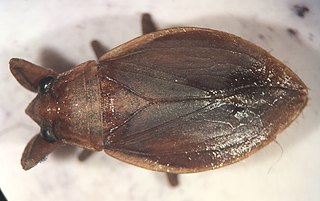 W
WAbedus immaculatus is a species of water bug in the family Belostomatidae. It is the only Abedus species found in the eastern United States, occurring throughout Florida north into Georgia and west along the Gulf Coast to Mississippi.
 W
WAbedus indentatus is a species of giant water bug in the family Belostomatidae. It is found in Central America and North America.
 W
WAmbrysus is a genus of creeping water bugs in the family Naucoridae. There are more than 90 described species in Ambrysus.
 W
WAmbrysus amargosus is a rare species of insect in the family Naucoridae, the creeping water bugs. It is known by the common name Ash Meadows naucorid. It is endemic to Ash Meadows in Nye County, Nevada, where it is now restricted to one system of springs. It is a federally listed threatened species of the United States.
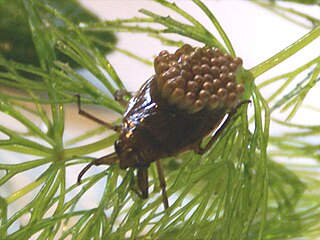 W
WAppasus is a genus of giant water bugs found in freshwater habitats in Asia and Africa.
 W
WBelostoma is a genus of insects in the hemipteran family Belostomatidae, known colloquially as giant water bugs. Members of this genus are native to freshwater habitats in the Americas, with the greatest species richness in tropical South America. Most species in the family Belostomatidae have historically been included in Belostoma, but several of these have been moved to other genera.
 W
WBenacus griseus is a species of giant water bug in the family Belostomatidae. It is the only species in the genus Benacus, which was formerly considered a subgenus of Lethocerus.
 W
WBuenoa marki is a species of backswimmer in the family Notonectidae. It is only known from the solution holes near the Pinelands Trail in Everglades National Park, Florida, although it may occur elsewhere.
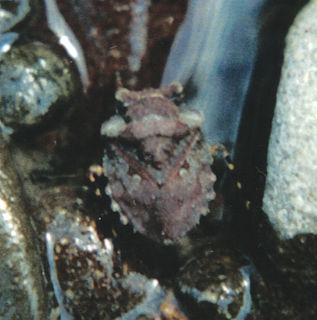 W
WThe Gelastocoridae is a family of about 100 species of insects in the suborder Heteroptera. These fall into two genera, about 15 species of Gelastocoris from the New World and 85 of Nerthra from the Old World. They are reminiscent of toads both in the warty appearance and hopping movements of some species.
 W
WGelastocoris is a genus of toad bugs in the family Gelastocoridae. There are more than 20 described species in Gelastocoris.
 W
WGelastocoris oculatus, the big-eyed toad bug, is a species of toad bug in the family Gelastocoridae. It is found in Central America and North America.
 W
WLethocerus americanus is a giant water bug in the family Belostomatidae, native to southern Canada and the United States. It typically has a length around 5–6 cm (2.0–2.4 in). It was originally classified as a species in genus Belostoma.
 W
WLethocerus deyrollei is a species of giant water bug that traditionally is included in the genus Lethocerus, although recent authorities place it in the Kirkaldyia. They are large, predatory and nocturnal insects. They are one of the best known giant water bugs and are found in Japan, Korea, east China, east Indochina and the Amur region of Russia. They are very common in much of their range, but have declined drastically in some regions and are considered threatened in Japan and Korea. They live in still waters with vegetation, hatching in the summer months and then overwintering half a year later as adults. They primarily feed on small fish, amphibians and aquatic insects, but have also been recorded taking water snakes and young turtles.
 W
WLethocerus insulanus is a species of giant water bug of the family Belostomatidae. Its common name is the giant water bug, but it is also called the electric light bug or giant fishkiller. These names are also used for various other members of the family, including the other Australian species, L. distinctifemur, which is similar to L. insulanus.
 W
WLethocerus medius is a species of giant water bug in the family Belostomatidae. It is found in Central America from northern Panama north throughout Mexico to southern Arizona, New Mexico, and Texas in the United States, and Cuba, Jamaica, the Cayman Islands, and the Bahamas.
 W
WLethocerus patruelis is a giant water bug in the family Belostomatidae. It is native to southeastern Europe, through Southwest Asia, to Pakistan, India and Burma. It is the largest European true bug and aquatic insect. Adult females are typically 7–8 cm (2.8–3.1 in) long, while the adult males are 6–7 cm (2.4–2.8 in).
 W
WLethocerus uhleri, or Uhler's water bug, is a species of giant water bug in the family Belostomatidae. It is found in eastern North America from New York, Michigan, and Wisconsin south to Florida and northern Tamaulipas.
 W
WNaucoridae is a small family of insects commonly known as the creeping water bugs and saucer bugs. They are similar in appearance and behavior to Belostomatidae, but considerably smaller, at 0.5–2 cm (0.2–0.8 in) long. Naucoridae are found around the world, but the greatest diversity is in tropical regions. They inhabit a wide range of freshwater habitats, ranging from still waters like ponds, to flowing rivers and even torrential streams. There are about 400 species in 40 genera in 5 subfamilies.
 W
WNepa apiculata is a species of waterscorpion in the family Nepidae. It is found in eastern North America.
 W
WNerthra is a genus of toad bugs in the family Gelastocoridae. There are at least 90 described species in Nerthra.
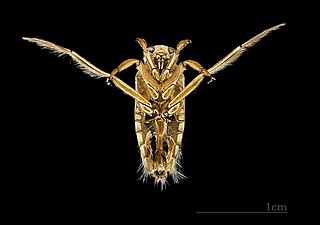 W
WNotonecta, or the common backswimmer, is a genus of backswimmer insects in the family Notonectidae. Species in this genus include:Notonecta borealis Notonecta glauca Notonecta hoffmanni Notonecta indica Notonecta insulata Notonecta irrorata Notonecta kirbyi Notonecta lobata Notonecta lunata Notonecta maculata Notonecta marmorea Notonecta meridionalis Notonecta montezuma Notonecta obliqua Notonecta ochrothoe Notonecta pallidula Notonecta petrunkevitchi Notonecta raleighi Notonecta repanda Notonecta shooteri Notonecta spinosa Notonecta uhleri Notonecta undulata Notonecta unifasciata Notonecta viridis
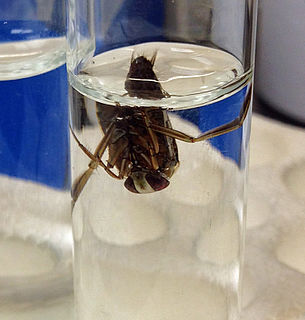 W
WNotonecta irrorata is a species of backswimmer native to North America first described by Philip Reese Uhler in 1879. Presence of N. irrorata in ponds is known to repel the oviposition of Culex mosquitoes.
 W
WNotonecta lunata is a species of backswimmer in the family Notonectidae. It is found in North America.
 W
WNotonecta uhleri is a species of backswimmer in the family Notonectidae. It is found in North America.
 W
WNotonectidae is a cosmopolitan family of aquatic insects in the order Hemiptera, commonly called backswimmers because they swim "upside down" (inverted). They are all predators and typically range from 0.5 to 1.5 cm (0.2–0.6 in) in length. They are similar in appearance to Corixidae, but can be separated by differences in their dorsal-ventral coloration, front legs, and predatory behavior. Their dorsum is convex, lightly colored without cross striations. Their front tarsi are not scoop-shaped and their hind legs are fringed for swimming. There are about 350 species in two subfamilies: Notonectinae with seven genera, and Anisopinae with four genera. Members in the former subfamily are often larger than those in the latter.
 W
WThe Ochteridae comprise a small family of insects. Eight genera with about 80 species have been described. They occur worldwide along the shore of various types of water and the greatest diversity is in tropical regions. They are "true bugs", being members of the order Hemiptera, and are in the suborder Heteroptera. Ochteridae commonly are known as the velvety shore bugs. They resemble the Saldidae shore bugs and have lengths ranging from 4.5 to 9 mm (0.18–0.35 in).
 W
WOchterus is a genus of velvety shore bugs in the family Ochteridae. There are more than 70 described species in Ochterus.
 W
WPelocoris is a genus of creeping water bugs in the family Naucoridae. There are about 15 described species in Pelocoris.
 W
WPelocoris balius is a species of creeping water bug in the family Naucoridae. It is found in Florida.
 W
WPelocoris femoratus is a species of creeping water bug in the family Naucoridae. It is found in Central America, North America, and South America.
 W
WRanatra fusca is a water stick-insect in the family Nepidae, native to North America. It is known by the common name brown water scorpion. It is generally 3.2–4.2 cm (1.3–1.7 in) long.